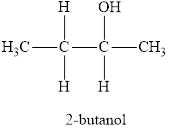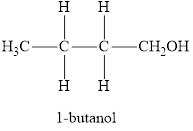
Concept explainers
(a)
Interpretation: The result of treating compound 1 with
Concept introduction:
Reduction reaction: The reaction in which addition of hydrogen takes place is known as reduction reaction.
The reduction of a
Alcohols are the hydrocarbons which have
Alcohols can be of three types on the basis of degree of carbon atom to which the
Primary alcohol: The
Secondary alcohol: The
Tertiary alcohol: The

(a)
Answer to Problem 62PS
The product obtained from the reaction of given compound

The systematic name of the product is 2-butanol and functional group is alcohol.
Explanation of Solution
Compound 1 s,

It is a ketone
The reaction between compound
The reduction of a ketone gives a secondary alcohol in presence of
The reaction is in which the compound

The product has same number of carbon atoms as in compound
The parent chain name will be butane and suffix will be “-ol” as there is one
Therefore, name of the product is 2-butanol and functional group is alcohol.
(b)
Interpretation: The structure of the reaction product from comounds 2 and 4 has to be drawn. The functional group of the product has to be identified
Concept introduction:
Ester: One
The name for an ester molecule can be written by using alkyl chain
Esterification reaction: Esters are prepared by the reaction of a
Here, the
(b)
Answer to Problem 62PS
The structure of the product is,

The functional group is an ester
Explanation of Solution
Compound 2 is,

It is a carboxylic acid
Compound 4 is,

It is a secondary alcohol
Esters are prepared by the reaction of a carboxylic acid and an alcohol molecule with the elimination of water molecule
The reaction is written below in which the compound
Here, the

The product has
(c)
Interpretation: The compound that results from the addition of
Concept introduction:
Hydrogenation: The addition of hydrogen to unsaturated compounds to convert into saturated compounds in the presence of catalyst.
An
Alcohols are the hydrocarbons which have
Alcohols can be of three types on the basis of degree of carbon atom to which the
(c)
Answer to Problem 62PS
The product obtained from the reaction of given compound

Explanation of Solution
Compound 3 is,

It is an alkene
The reaction between compound
In this reaction, the compound

The product has same number of carbon atoms as in compound
The parent chain name will be butane
The suffix will be “-ol” as there is one
Therefore, name of the product is 1-butanol and functional group is alcohol.
(d)
Interpretation: The compound that results from the addition of
Concept introduction:
The reaction of carboxylic acid with
(d)
Answer to Problem 62PS
The product obtained from the reaction of given compound

Explanation of Solution
The reaction of carboxylic acid with
The product obtained is the sodium salt of the acid and water.
The reaction of compound

Want to see more full solutions like this?
Chapter 23 Solutions
Chemistry & Chemical Reactivity, Hybrid Edition (with OWLv2 24-Months Printed Access Card)
- identify which spectrum is for acetaminophen and which is for phenacetinarrow_forwardThe Concept of Aromaticity 21.15 State the number of 2p orbital electrons in each molecule or ion. (a) (b) (e) (f) (c) (d) (h) (i) DA (k) 21.16 Which of the molecules and ions given in Problem 21.15 are aromatic according to the Hückel criteria? Which, if planar, would be antiaromatic? 21.17 Which of the following structures are considered aromatic according to the Hückel criteria? ---0-0 (a) (b) (c) (d) (e) (h) H -H .8.0- 21.18 Which of the molecules and ions from Problem 21.17 have electrons donated by a heteroatom?arrow_forward1. Show the steps necessary to make 2-methyl-4-nonene using a Wittig reaction. Start with triphenylphosphine and an alkyl halide. After that you may use any other organic or inorganic reagents. 2. Write in the product of this reaction: CH3 CH₂ (C6H5)₂CuLi H₂O+arrow_forward
- 3. Name this compound properly, including stereochemistry. H₂C H3C CH3 OH 4. Show the step(s) necessary to transform the compound on the left into the acid on the right. Bri CH2 5. Write in the product of this LiAlH4 Br H₂C OHarrow_forwardWhat are the major products of the following reaction? Please provide a detailed explanation and a drawing to show how the reaction proceeds.arrow_forwardWhat are the major products of the following enolate alkylation reaction? Please include a detailed explanation as well as a drawing as to how the reaction proceeds.arrow_forward
- A block of zinc has an initial temperature of 94.2 degrees celcius and is immererd in 105 g of water at 21.90 degrees celcius. At thermal equilibrium, the final temperature is 25.20 degrees celcius. What is the mass of the zinc block? Cs(Zn) = 0.390 J/gxdegrees celcius Cs(H2O) = 4.18 J/gx degrees celcusarrow_forwardPotential Energy (kJ) 1. Consider these three reactions as the elementary steps in the mechanism for a chemical reaction. AH = -950 kJ AH = 575 kJ (i) Cl₂ (g) + Pt (s) 2C1 (g) + Pt (s) Ea = 1550 kJ (ii) Cl (g)+ CO (g) + Pt (s) → CICO (g) + Pt (s) (iii) Cl (g) + CICO (g) → Cl₂CO (g) Ea = 2240 kJ Ea = 2350 kJ AH = -825 kJ 2600 2400 2200 2000 1800 1600 1400 1200 1000 a. Draw the potential energy diagram for the reaction. Label the data points for clarity. The potential energy of the reactants is 600 kJ 800 600 400 200 0 -200- -400 -600- -800- Reaction Progressarrow_forwardCan u help me figure out the reaction mechanisms for these, idk where to even startarrow_forward
- Hi, I need your help with the drawing, please. I have attached the question along with my lab instructions. Please use the reaction from the lab only, as we are not allowed to use outside sources. Thank you!arrow_forwardHi, I need your help i dont know which one to draw please. I’ve attached the question along with my lab instructions. Please use the reaction from the lab only, as we are not allowed to use outside sources. Thank you!arrow_forward5. Write the formation reaction of the following complex compounds from the following reactants: 6. AgNO₃ + K₂CrO₂ + NH₄OH → 7. HgNO₃ + excess KI → 8. Al(NO₃)₃ + excess NaOH →arrow_forward
 Chemistry & Chemical ReactivityChemistryISBN:9781337399074Author:John C. Kotz, Paul M. Treichel, John Townsend, David TreichelPublisher:Cengage Learning
Chemistry & Chemical ReactivityChemistryISBN:9781337399074Author:John C. Kotz, Paul M. Treichel, John Townsend, David TreichelPublisher:Cengage Learning Chemistry & Chemical ReactivityChemistryISBN:9781133949640Author:John C. Kotz, Paul M. Treichel, John Townsend, David TreichelPublisher:Cengage Learning
Chemistry & Chemical ReactivityChemistryISBN:9781133949640Author:John C. Kotz, Paul M. Treichel, John Townsend, David TreichelPublisher:Cengage Learning Chemistry: Principles and ReactionsChemistryISBN:9781305079373Author:William L. Masterton, Cecile N. HurleyPublisher:Cengage Learning
Chemistry: Principles and ReactionsChemistryISBN:9781305079373Author:William L. Masterton, Cecile N. HurleyPublisher:Cengage Learning Chemistry: The Molecular ScienceChemistryISBN:9781285199047Author:John W. Moore, Conrad L. StanitskiPublisher:Cengage Learning
Chemistry: The Molecular ScienceChemistryISBN:9781285199047Author:John W. Moore, Conrad L. StanitskiPublisher:Cengage Learning



